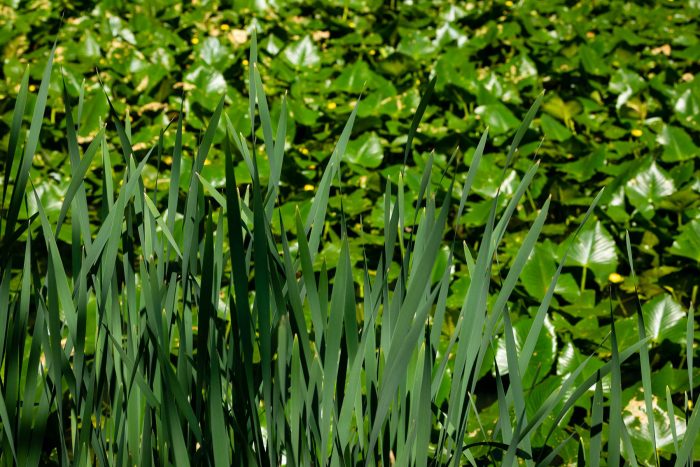Cattails
Typha spp.
Cattails are a native perennial plant with distinctive brown, sausage-shaped “tails.” They grow in fresh and brackish wetlands throughout the Chesapeake Bay watershed.
This section shows one large critter image at a time. Use the thumbnails that follow to select a specific image to display here.

This gallery contains a grid of small thumbnails. Selecting a thumbnail will change the main image in the preceding section.
Appearance
Two species of cattails can be found in the Chesapeake Bay watershed: the common or broad-leaved cattail (Typha latifolia) and narrow-leaved cattail (Typha angustifolia).
Cattails have a brown, sausage-shaped “tail” full of tightly packed seeds on top of a long, stiff stalk. This is the female flower spike. These tails can grow 2 to 6 inches in length. The small, slender spike on top of the tail is the male portion of the flower. The narrow-leaved cattail has a gap between the tail and the spike. Cattail leaves are flat and pale green. Common cattail leaves can be up to 2 inches wide, while narrow-leaved cattail leaves are not as wide. Cattails grow to 6 feet tall.
Reproduction and life cycle
In autumn, the flower spikes mature into seed heads. Wind, water and other natural disturbances scatter the soft, fuzzy seeds. Cattails also reproduce asexually when underground rhizomes (a type of plant stem with nodes that roots grow from) spread. A single acre of cattails may derive from just a few original plants.
Did you know?
- Cattails are considered to be invasive in some areas because they grow rapidly and crowd out other plant species.
- Cattails form dense colonies in any area where the soil remains wet or flooded during the growing season. Common cattails grow mainly in fresh water, while narrow-leaved cattails range into brackish waters. Common cattails usually grow in shallower water than narrow-leaved cattails.
- Native Americans have found medicinal uses for parts of the cattail plant, such as preventing chafing, healing burns, curing kidney stones and treating whooping cough. Cattails have also been used for food, drink and building materials.
- If you pull a tuft from a cattail’s tail, it will expand into a handful of downy seeds.
Sources and additional information
- Life in the Chesapeake Bay by Alice Jane Lippson and Robert L. Lippson
- Chesapeake Bay: Nature of the Estuary, A Field Guide by Christopher P. White
- PLANTS Profile for Typha latifolia and Typha angustifolia – USDA Natural Resources Conservation Service
- Typha latifolia and Typha angustifolia – U.S. Forest Service
